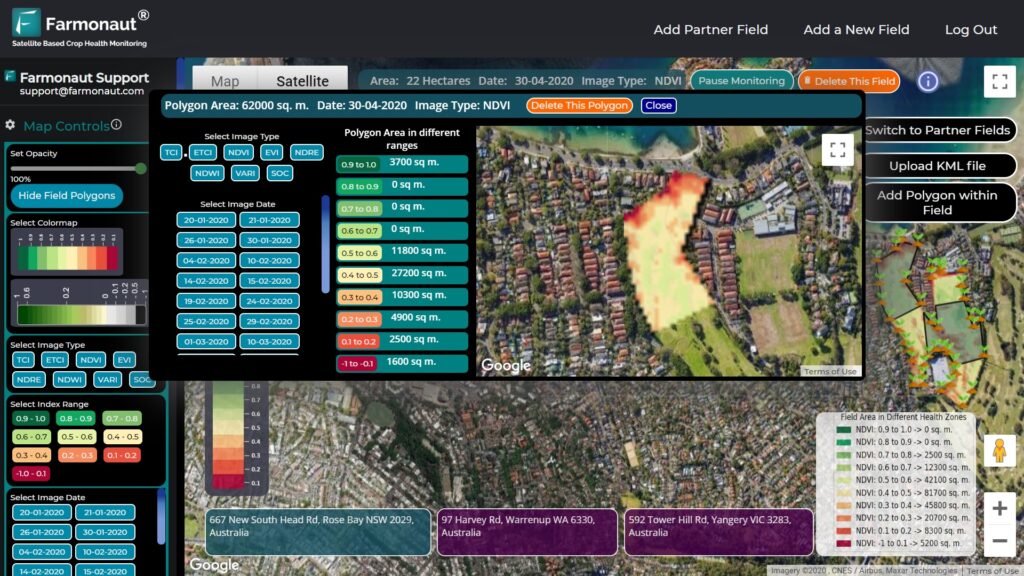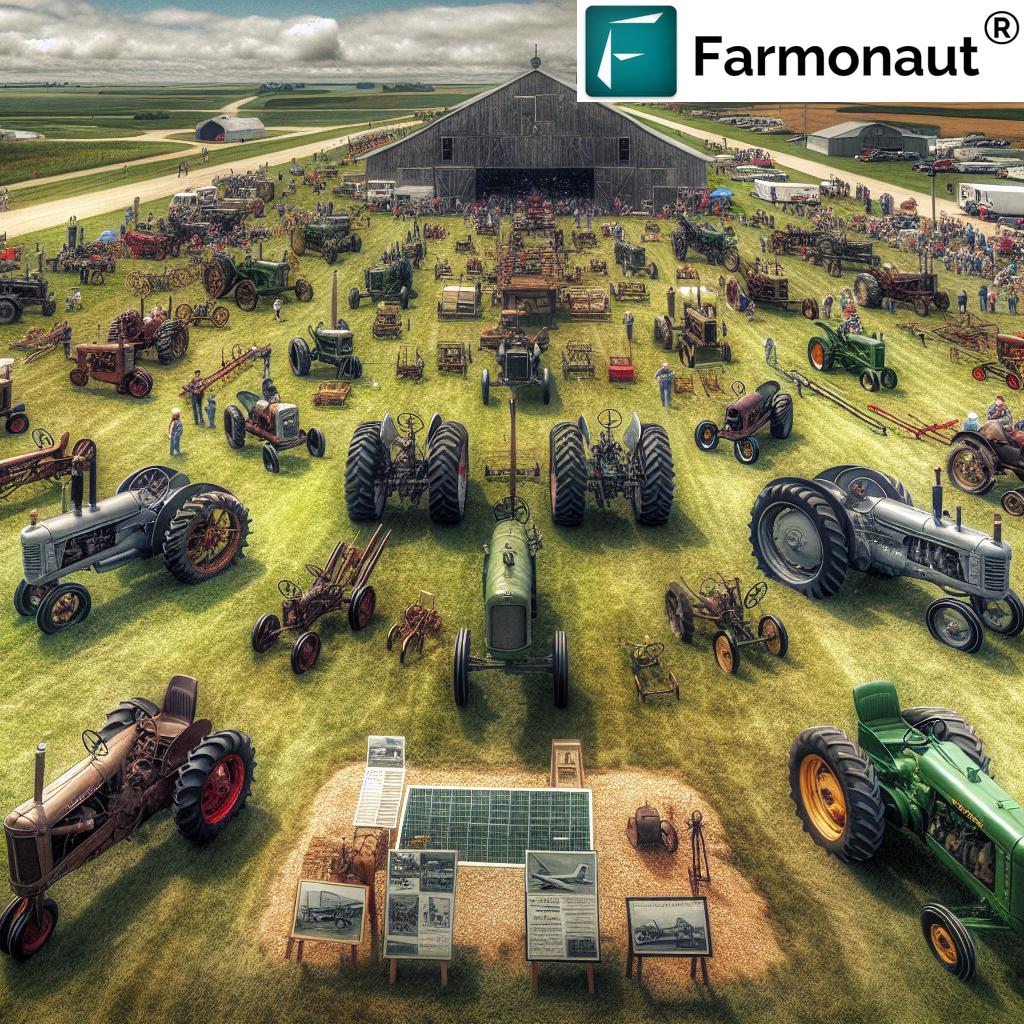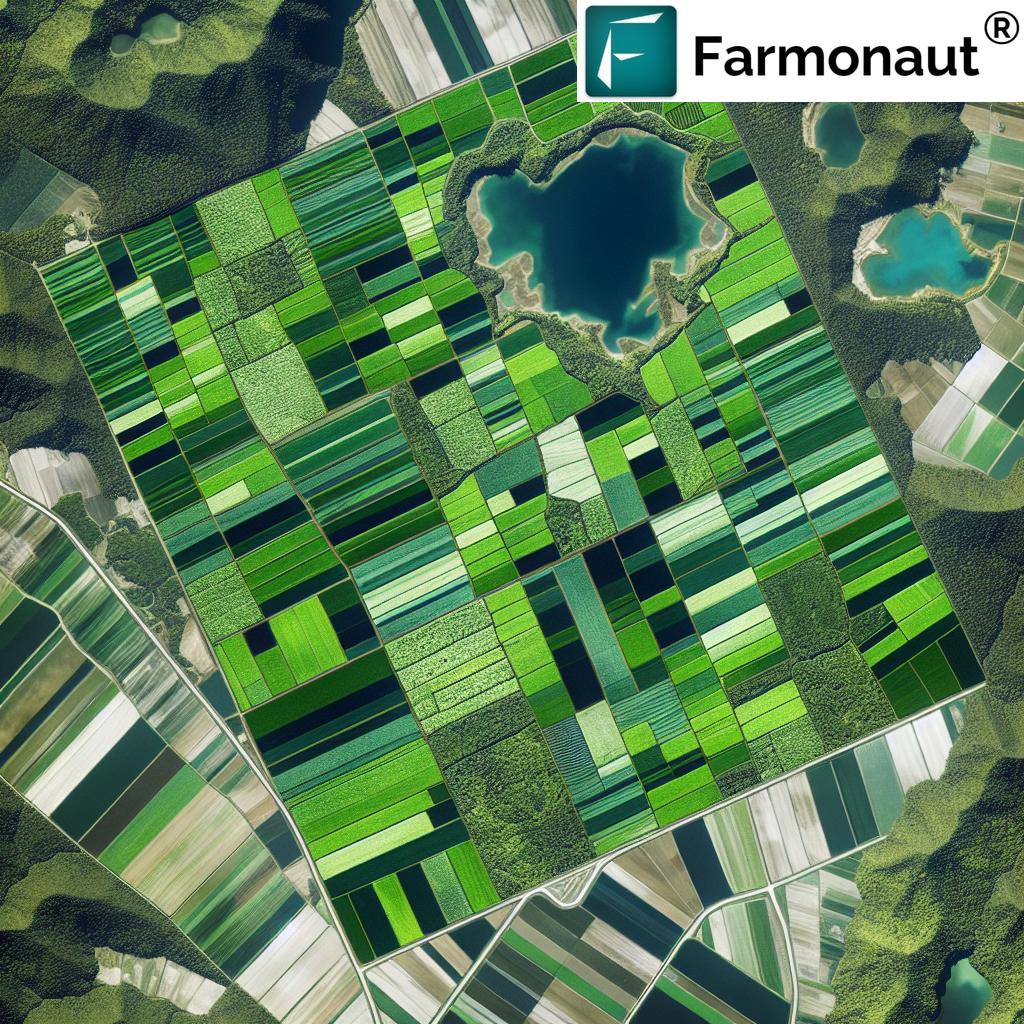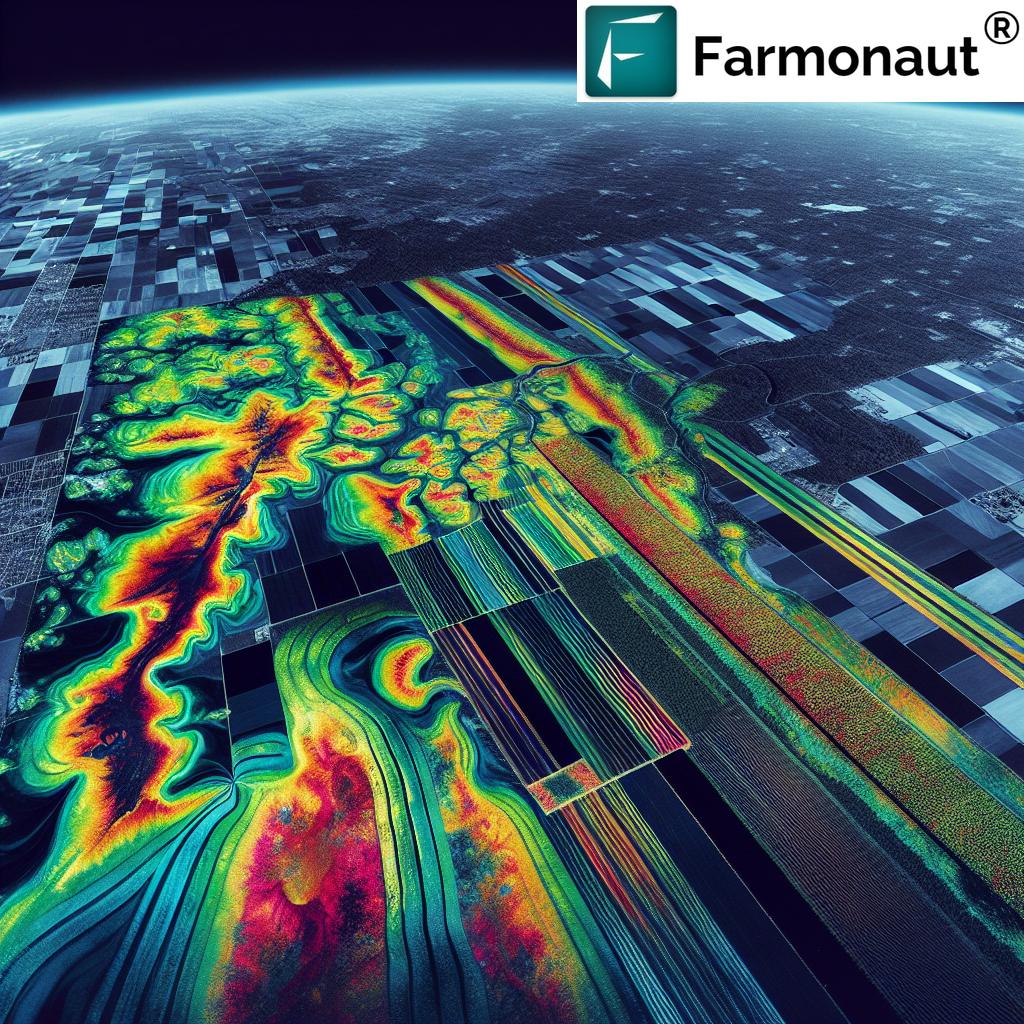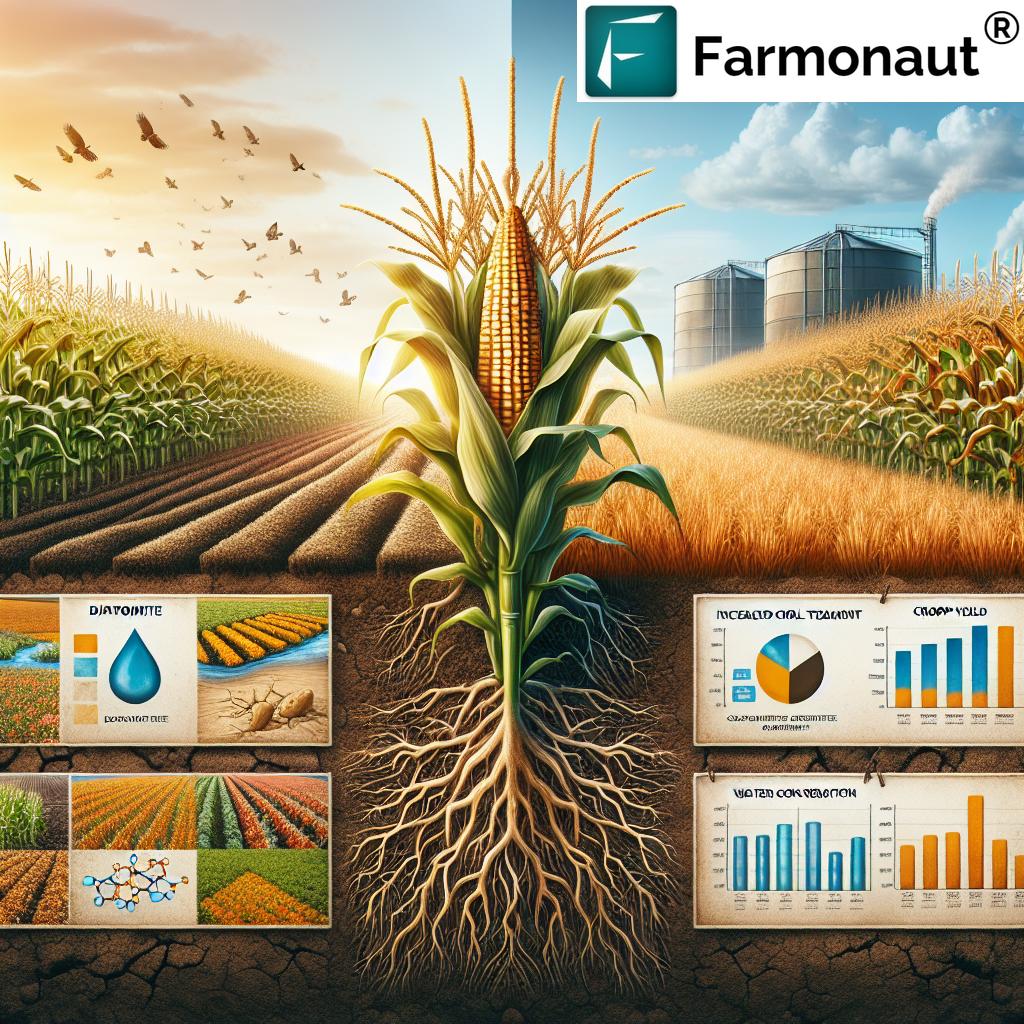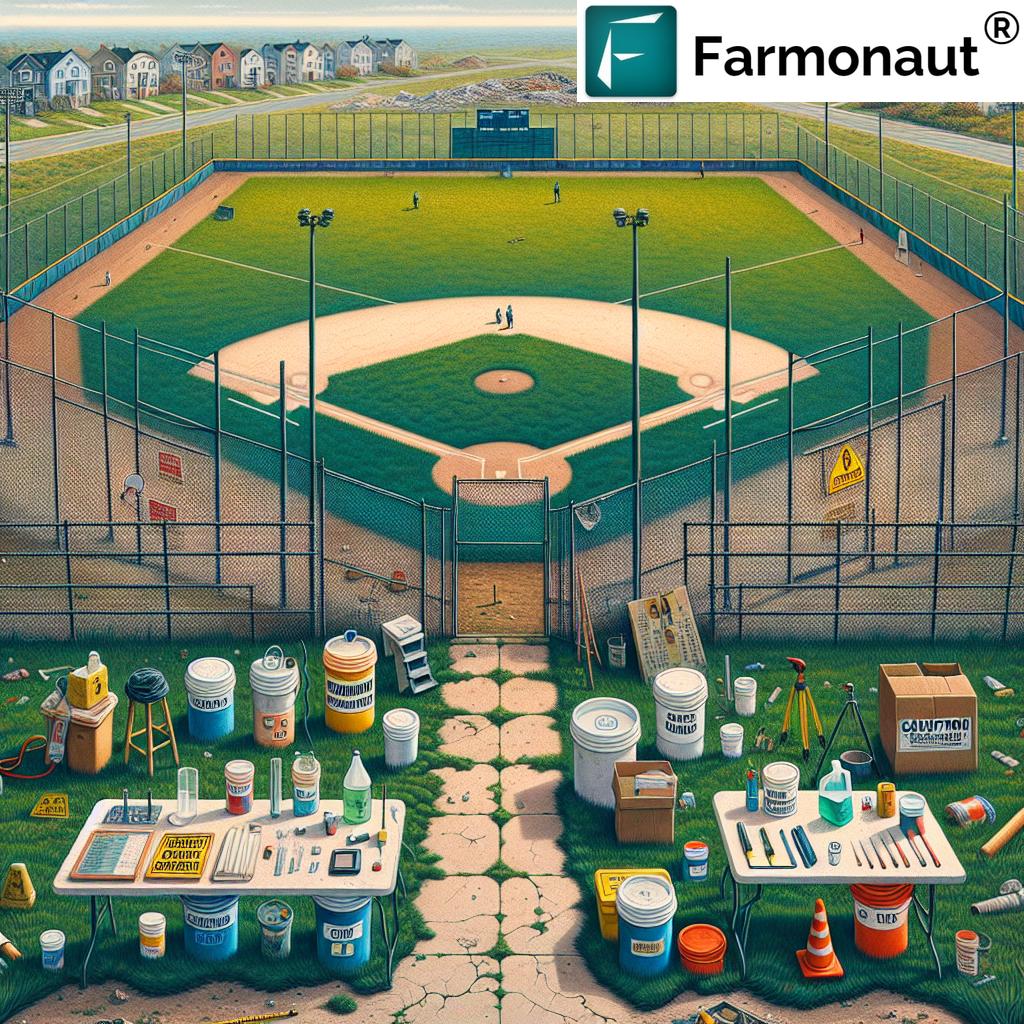Mastering the Hay Market: USDA’s Guide to Premium Alfalfa and Grass Hay Prices for November
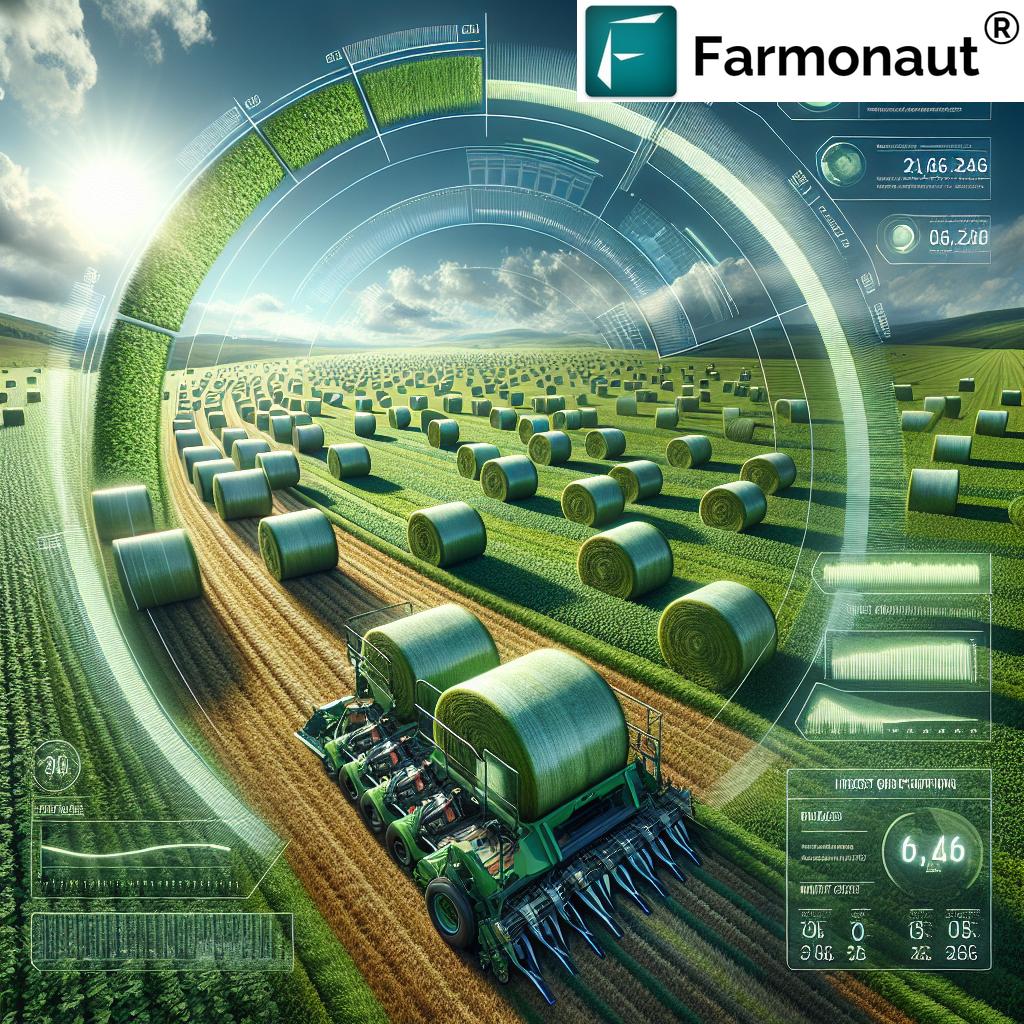
“USDA hay reports classify alfalfa into 5 grades, from supreme to utility, based on factors like leaf content and stem texture.”
Welcome to our comprehensive guide on mastering the hay market, where we’ll delve into the USDA’s latest report on premium alfalfa and grass hay prices for November. As experts in agricultural technology and market analysis, we at Farmonaut are excited to share our insights on this crucial aspect of the forage industry.
In this blog post, we’ll explore the intricacies of hay market prices, alfalfa quality, and the factors that influence the value of this essential agricultural commodity. Whether you’re a grower, buyer, or industry professional, understanding these dynamics is key to making informed decisions in your agricultural operations.
Understanding the USDA Hay Report
The USDA hay report is a weekly publication that provides invaluable information on hay market prices and quality designations across various states. This report is a cornerstone for anyone involved in the forage industry, offering a standardized assessment of hay quality and pricing trends.
- Reports are typically released every Friday
- Covers multiple states and regions
- Includes data on alfalfa and grass hay varieties
- Provides both FOB barn and delivered prices
Understanding how to interpret this report is crucial for navigating the hay market effectively. Let’s break down some of the key components you’ll find in these weekly updates.
Hay Quality Grades and Characteristics
One of the most important aspects of the USDA hay report is the grading system used to classify hay quality. This system helps buyers and sellers communicate effectively about the value and characteristics of the hay being traded.
| Hay Grade | Maturity Stage | Leaf Content (%) | Stem Texture | Color | Protein Content (%) | Relative Feed Value (RFV) | Estimated Price Range ($/ton) |
|---|---|---|---|---|---|---|---|
| Supreme | Very early | >55% | Very soft | Green | >22% | >185 | 250-300 |
| Premium | Early | 50-55% | Soft | Green | 20-22% | 170-185 | 220-250 |
| Good | Mid | 45-50% | Slightly coarse | Light green | 18-20% | 150-170 | 180-220 |
| Fair | Late | 40-45% | Coarse | Yellow-green | 16-18% | 130-150 | 140-180 |
| Utility | Very late | <40% | Very coarse | Yellow-brown | <16% | <130 | 100-140 |
Let’s explore each of these grades in more detail:
Supreme Grade Hay
Supreme grade hay is the cream of the crop, characterized by:
- Very early maturity
- High leaf content (over 55%)
- Very soft stems
- Vibrant green color
- High protein content (over 22%)
- Excellent Relative Feed Value (RFV) exceeding 185
This grade of hay commands the highest prices in the market due to its exceptional nutritional value and palatability. It’s particularly sought after by dairy farmers and those raising high-performance animals.
Premium Grade Hay
Premium grade hay is a close second to supreme, offering:
- Early maturity
- Good leaf content (50-55%)
- Soft stems
- Green color
- High protein content (20-22%)
- Very good RFV between 170-185
This grade is still considered high-quality forage and is suitable for most livestock with high nutritional requirements.
Good Grade Hay
Good grade hay represents average quality forage:
- Mid-maturity stage
- Moderate leaf content (45-50%)
- Slightly coarse stems
- Light green color
- Moderate protein content (18-20%)
- RFV between 150-170
This grade is suitable for many livestock operations and can be a cost-effective option for animals with lower nutritional needs.
Fair Grade Hay
Fair grade hay is of lower quality but still usable:
- Late maturity
- Lower leaf content (40-45%)
- Coarse stems
- Yellow-green color
- Lower protein content (16-18%)
- RFV between 130-150
This grade is often used for mature, non-lactating animals or as a roughage source in mixed rations.
Utility Grade Hay
Utility grade is the lowest quality classification:
- Very late maturity
- Low leaf content (less than 40%)
- Very coarse stems
- Yellow-brown color
- Low protein content (less than 16%)
- RFV below 130
This grade is typically used as bedding or filler in low-quality feed rations.
“Premium hay prices can vary significantly across states, with FOB barn rates and delivered prices reflecting local market conditions.”
Factors Influencing Hay Quality and Pricing
Several key factors play a role in determining the quality and, consequently, the price of hay in the market. Understanding these factors is crucial for both producers aiming to maximize their returns and buyers looking to secure the best value for their livestock needs.
1. Maturity at Harvest
The stage of maturity at which hay is harvested is perhaps the single most important factor affecting its quality. Early maturity hay is generally of higher quality due to:
- Higher protein content
- Lower fiber levels
- Improved digestibility
- Better palatability for livestock
Farmers must balance the trade-off between yield and quality, as waiting too long to harvest can result in higher yields but lower overall quality.
2. Leaf Content and Retention
Leaves are the most nutritious part of the plant, containing higher levels of protein and digestible nutrients compared to stems. High-quality hay should have:
- A high leaf-to-stem ratio
- Minimal leaf shatter during harvesting and baling
Proper harvesting techniques and careful handling are essential to preserve leaf content and maintain hay quality.
3. Stem Texture
The texture of the stems is another important quality indicator:
- Soft, pliable stems are characteristic of high-quality hay
- Coarse, woody stems indicate lower quality and reduced digestibility
Stem texture is closely related to the plant’s maturity at harvest, with younger plants having softer stems.
4. Color
While color alone is not a definitive measure of nutritional value, it can be an indicator of hay quality:
- Bright green color suggests proper curing and high nutritional value
- Yellow or brown coloration may indicate weathering, overcuring, or prolonged storage
It’s important to note that color can be misleading, and chemical analysis is the most accurate way to determine nutritional content.
5. Presence of Weeds, Mold, and Foreign Material
The purity of the hay crop is crucial for quality assessment:
- Weed-free hay is more desirable and commands higher prices
- Presence of mold can significantly reduce hay quality and may be harmful to animals
- Foreign material (e.g., dirt, rocks) decreases overall quality and can be dangerous if ingested
Proper field management and careful harvesting practices help minimize these issues.
6. Bale Size and Density
While not directly related to nutritional quality, bale characteristics can affect pricing:
- Large, dense bales are often preferred for ease of transport and storage
- Smaller bales may command a premium in some markets, particularly for small-scale buyers
Bale size and density can also impact storage quality and long-term preservation of hay.
7. Regional Supply and Demand
Market forces play a significant role in hay pricing:
- Areas experiencing drought may see higher hay prices due to reduced local supply
- Regions with a concentration of dairy or horse farms often have higher demand for premium hay
Understanding regional market dynamics is crucial for both buyers and sellers in the hay market.
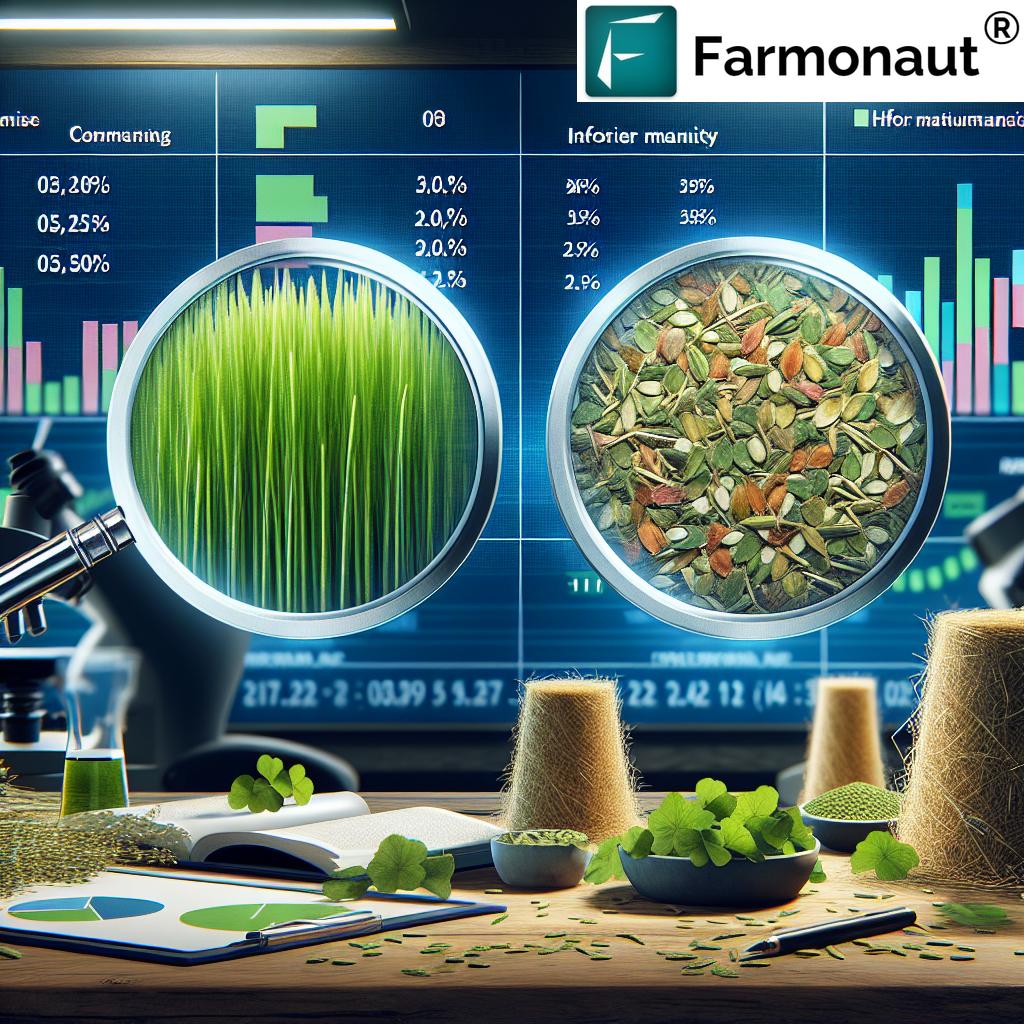
Interpreting Hay Market Prices
The USDA hay report provides pricing information in two main formats: FOB (Free On Board) barn prices and delivered prices. Understanding the difference between these pricing structures is crucial for both buyers and sellers in the hay market.
FOB Barn Prices
FOB barn prices represent the cost of hay at the point of origin, typically the farmer’s storage facility. This price includes:
- The base cost of the hay
- Any on-farm handling and storage costs
- Loading fees (if applicable)
FOB pricing does not include transportation costs, which are typically the responsibility of the buyer. This pricing model is advantageous for local buyers who can arrange their own transportation, potentially saving on overall costs.
Delivered Prices
Delivered prices, as the name suggests, include the cost of transporting the hay to the buyer’s location. These prices encompass:
- The base cost of the hay
- All handling and storage costs
- Transportation fees
Delivered prices are generally higher than FOB prices but offer convenience for buyers who don’t have the means to transport large quantities of hay.
Factors Affecting Price Variations
Several factors can cause hay prices to vary significantly across different regions and even within the same state:
- Local Supply and Demand: Areas with high concentrations of livestock or drought conditions may see higher prices.
- Transportation Costs: Distance from major hay-producing regions can significantly impact delivered prices.
- Seasonal Fluctuations: Prices often peak in winter when demand is high and supply is limited.
- Quality Variations: Premium grades command higher prices compared to lower grades.
- Competing Crops: The profitability of alternative crops can influence hay acreage and prices.
At Farmonaut, we understand the importance of staying informed about these market dynamics. Our satellite-based crop monitoring technology can help hay producers optimize their yields and quality, potentially leading to better market prices. Learn more about our services here.
High Nutritive Value Forage: Why It Matters
Understanding the concept of high nutritive value forage is crucial for both hay producers and livestock owners. This term refers to hay that provides optimal nutrition for animals, resulting in better health outcomes and potentially higher productivity.
Characteristics of High Nutritive Value Forage
- High Protein Content: Essential for animal growth and milk production
- Low Fiber Levels: Improves digestibility and energy availability
- Balanced Mineral Content: Supports overall animal health and metabolic functions
- High Digestibility: Allows animals to extract maximum nutrients from each bite
Producing high nutritive value forage requires careful management throughout the growing and harvesting process. Farmers must consider factors such as:
- Optimal harvest timing to balance yield and quality
- Proper fertilization to ensure nutrient-rich plants
- Weed control to maintain purity of the forage crop
- Careful handling during harvest to preserve leaves and nutrients
At Farmonaut, our satellite-based crop monitoring can help farmers track the development of their hay crops, ensuring they harvest at the optimal time for maximum nutritional value. Download our Android app or iOS app to get started with precision agriculture for your hay production.
Alfalfa vs. Grass Hay: Understanding the Differences
While both alfalfa and grass hay are important forage crops, they have distinct characteristics that affect their quality, pricing, and suitability for different livestock needs.
Alfalfa Hay
Alfalfa, often referred to as the “Queen of Forages,” is known for its high nutritional value and is particularly popular in dairy operations.
- Protein Content: Generally higher than grass hay (15-22% in high-quality cuts)
- Calcium Levels: Excellent source of calcium
- Digestibility: High digestibility when cut at the right stage
- Yield: Often produces higher yields per acre compared to grass hay
Grass Hay
Grass hay includes various species such as timothy, orchardgrass, and brome. It’s often used for horses and beef cattle.
- Protein Content: Generally lower than alfalfa (8-14% in good quality cuts)
- Fiber Content: Higher in fiber, which can be beneficial for some animals
- Digestibility: Varies widely depending on maturity at harvest
- Versatility: Suitable for a wide range of livestock, including horses
The choice between alfalfa and grass hay often depends on the specific nutritional needs of the animals being fed. Some farmers opt for mixed hay, combining the benefits of both types.
Market Trends and Pricing Dynamics
Understanding current market trends and pricing dynamics is crucial for anyone involved in the hay industry. Let’s explore some key factors influencing the hay market as of November:
Regional Variations
Hay prices can vary significantly across different regions due to local supply and demand dynamics. For example:
- Drought-affected areas may see higher prices due to reduced local production
- Regions with high concentrations of dairy farms often have stronger demand for premium alfalfa
- Areas with a large horse population may have steady demand for high-quality grass hay
Seasonal Fluctuations
The hay market typically experiences seasonal price fluctuations:
- Prices often peak in late winter/early spring when stored supplies run low
- New crop hay entering the market in summer can lead to price decreases
- Fall prices may stabilize as buyers stock up for winter feeding
Quality Premium
High-quality hay consistently commands a premium in the market:
- Supreme and Premium grade alfalfa can sell for significantly more than lower grades
- Weather-damaged or over-mature hay may sell at a discount
Transportation Costs
With rising fuel prices, transportation costs play a significant role in delivered hay prices:
- Long-distance transport can add substantially to the final cost
- Local markets may have an advantage in terms of pricing
At Farmonaut, we believe that staying informed about these market dynamics is crucial for making sound decisions in hay production and purchasing. Our satellite-based crop monitoring can help producers optimize their hay quality, potentially leading to better market prices. Learn about our API services for integrating real-time crop data into your decision-making process.
Leveraging Technology in Hay Production and Marketing
In today’s rapidly evolving agricultural landscape, technology plays a crucial role in optimizing hay production and marketing strategies. At Farmonaut, we’re at the forefront of this technological revolution, offering innovative solutions to help farmers make data-driven decisions.
Satellite-Based Crop Monitoring
Our advanced satellite imagery technology provides farmers with valuable insights into their hay fields:
- Crop Health Monitoring: Track vegetation health indices like NDVI to identify potential issues early
- Soil Moisture Analysis: Optimize irrigation schedules for improved hay quality
- Yield Estimation: Make informed decisions about harvest timing and market strategies
By leveraging these tools, hay producers can potentially improve their crop quality and yields, leading to better market prices and increased profitability.
AI-Powered Advisory Systems
Our Jeevn AI system provides personalized recommendations based on real-time data:
- Weather Forecasts: Plan harvesting activities around optimal weather conditions
- Pest and Disease Alerts: Take proactive measures to protect hay quality
- Fertilization Advice: Optimize nutrient application for premium hay production
These AI-driven insights can help farmers make timely decisions that impact hay quality and market value.
Sustainable Practices in Hay Production
As the agricultural industry moves towards more sustainable practices, hay producers are finding ways to balance productivity with environmental stewardship. At Farmonaut, we support these efforts through our technology solutions.
Water Management
Efficient water use is crucial for sustainable hay production:
- Our soil moisture analysis helps optimize irrigation schedules
- Reduced water usage leads to lower production costs and environmental impact
Precision Agriculture
By applying inputs precisely where and when they’re needed, farmers can:
- Minimize chemical use
- Reduce environmental impact
- Potentially improve hay quality
Carbon Footprint Monitoring
Our carbon footprinting tools allow farmers to:
- Track and reduce their environmental impact
- Potentially access carbon credit markets
- Meet growing consumer demand for sustainably produced hay
By embracing these sustainable practices, hay producers can not only reduce their environmental impact but also potentially access premium markets and improve their bottom line.
Future Outlook for the Hay Market
As we look towards the future of the hay market, several trends and factors are likely to shape the industry:
Climate Change Impacts
- Shifting growing seasons may affect hay production cycles
- Increased frequency of extreme weather events could lead to supply volatility
- Adaptation strategies will be crucial for maintaining consistent production
Technological Advancements
- Continued integration of precision agriculture techniques
- Improved harvesting and baling equipment for better quality preservation
- Enhanced storage solutions to maintain hay quality long-term
Market Diversification
- Growing interest in specialty hay markets (e.g., for small pets, organic certification)
- Potential for new uses of hay in industrial applications
- Increased focus on direct-to-consumer marketing channels
At Farmonaut, we’re committed to helping hay producers navigate these future challenges and opportunities. Our continuously evolving technology platform is designed to adapt to the changing needs of the agricultural sector.
Conclusion
Mastering the hay market requires a deep understanding of quality factors, pricing dynamics, and market trends. By leveraging the latest USDA reports and embracing technological solutions like those offered by Farmonaut, hay producers and buyers can make informed decisions that optimize their operations.
Remember, the key to success in the hay market lies in producing and sourcing high-quality forage that meets the nutritional needs of livestock while balancing production costs and market demands. Stay informed, embrace innovation, and always strive for quality in your hay production or purchasing strategies.
For more information on how Farmonaut can help you optimize your hay production or make better purchasing decisions, visit our website or download our mobile app today.
FAQ Section
Q: What factors most significantly impact hay prices?
A: The most significant factors impacting hay prices include quality (grade), local supply and demand, seasonal variations, transportation costs, and overall market conditions.
Q: How often are USDA hay reports released?
A: USDA hay reports are typically released weekly, usually on Fridays.
Q: What’s the difference between alfalfa and grass hay?
A: Alfalfa hay generally has higher protein content and is often preferred for dairy cattle, while grass hay is lower in protein but higher in fiber, making it suitable for a wider range of livestock, including horses.
Q: How can technology improve hay production?
A: Technology like satellite-based crop monitoring, AI advisory systems, and precision agriculture tools can help optimize irrigation, fertilization, and harvest timing, potentially leading to improved hay quality and yields.
Q: What does FOB mean in hay pricing?
A: FOB stands for “Free On Board” and refers to the price of hay at the point of origin (typically the farm), not including transportation costs.




